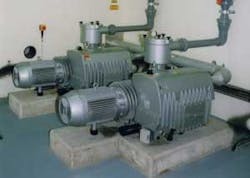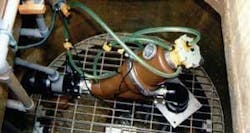Operating a vacuum sewerage system differs from traditional gravity systems. Gergely Fábry of Axis Consulting Ltd. explain key points on how to best operate and maintain vacuum sewerage systems.
Since 1994, the UK company Iseki Vacuum Systems has installed 11,000 collection chambers and 1,500 kilometres of pipework in Hungary. Relatively large systems, each vacuum collection station operates on average 1,200 households; however these systems are easy to operate if a few simple rules are followed.
The design and construction of a vacuum sewerage system should be carried out with plenty of cooperation with the system owner (licensor), who possesses long-term experience and skill, and especially the required approvals and certified knowledge of system principles of vacuum sewerage system.
Expert knowledge of this system cannot be underestimated. The vacuum system can be operated easily with good parameters only if the design, construction and the operation follows the instructions of the licensor. Key staff of the operating company should take active part in the vacuum sewerage installation projects by learning the principles of the technology and the design of the system, in addition to following the construction works.
Network requirements
One of the most important rules is that back fall, a situation that causes sewage to flow backwards or be trapped, is not allowed in the vacuum pipe between lifts. The slope should follow the designed profile. In general, the 0.2% slope of the PE pipework should be adjusted on the bedding using lasers. The bedding must be well compacted and consist of correct materials. Pipes with bows should not be installed. If there is a backfall due to either incorrect bedding, or any other mistake, water collected in the deeps might lead to waterlogging of the system causing a vacuum shortage at the end of line. Vacuum and pressure tests must be performed when the pipework is ready.
Chamber requirements
The manhole and gravity pipework connected to the chambers must be watertight and checked in accordance with local standards. Surface water should not enter the manhole. The volume of a manhole must be larger than the 25% of the daily flow rate in order to prevent flooding during any breakdown.
The vent of the manhole must be managed through cleanouts in a way that prevents large volumes of cold air to enter the vacuum pipework, and suck down into the water traps and syphons in the household. Gravity and manholes must be cleaned before the installation of the vacuum interface valves.
A checklist for each and every manhole filled in and signed by the person who installed the valve. This datasheet can be used later during the operation to log any troubleshootings, maintenance and events, and to support further technical evaluations.
Testing
The operation philosophy, interlock conditions, automatic start and all other functions should be tested in accordance with the prescriptions of the licensor. The system requires 100 % standby or assist pump must be available in automatic operation. All functions of the automatic recovery system must be tested. A telemetry system should send the main operation parameters, including low vacuum level, breakdown, and black out alarm signals, to the operator in duty.
After successfully passing the vacuum tests, the droptests, and the station function tests, check the end-of-line vacuum operations by feeding the line at the far end with approximately 0.5 litre/second flowrate for a long time with simultaneous vacuum pressure recording. This step should reveal any backfalls in the pipework.
The next step is to install the valves and fine-tune the air water ratio of the system, which must always be started from the station.
Trial operation with sewage
The operator can start connecting the system to house connections when the system passes all tests and trials, and when at least 50% of the houses are ready. In Hungary, homeowners pay for the part of gravity house connection inside of their own property, between the house and the fence. Skilled contractors should install private services.
Unfortunately, more debris and dirt can enter the manhole temporarily during service connection, which increases the potential of valve jams, so the service line and manhole should be carefully cleaned again.
Residents should be informed about the sewage collection system and instructed to refrain from disposing of non-sewage materials, such as oil, textile, household waste, disposable napkins, residual of construction materials, into the system. The technical consequences to the system and the sewage treatment plant should be made known to system users. If, for any reason, foreign material enters the system, the user should call the vacuum system operator and inform them so the problem can be resolved.
Operational strategies
Vacuum sewerage systems are automatically operated so no personnel needs to be present, but skilled operators are available via a telemetry system in case a problem arises. However, automatic operations does not mean that no maintenance, problem prevention and trouble-shooting is necessary. Sewage system operations are typically organised in two different approaches. The first approach is reactive, letting the system run automatically and fix the problem when it happens. Unfortunately, this traditional approach is too often practiced in traditional gravity sewerage systems and vacuum sewerage systems. The second approach is based on a prevention strategy, in which the operator continuously evaluates system parameters to stop problems from developing. The operator also services the system and keeps the entire system in optimum operating condition; therefore the number of defects and energy demand will be minimal, and the system operation will be reliable.
Preventive maintenance
The operator should record and evaluate the daily flow rate, the number of running hours of discharge and vacuum pumps, and the daily energy demand. One of the most important parameters is the kWh/m3 specific energy use, ie. the kWH demand of one m3 sewage collection and discharge to the treatment plant. The value of it is between 0.5 and 1 kWH/m3 at a well-built and maintained large-scale system. This value will depend on the size of the system, the air water ratio, the distance of the treatment plant, the local topography and the rate of exploitation of the system. A large-scale system with a distant sewage treatment plant and relatively less, mainly uphill flow, will have higher value. The value is relatively high at the beginning of the operation and as live connections increase, the specific energy use will decrease and set at an optimum value. Every individual system has its own optimum value.
The operator should follow the daily values and, in this way, can filter out from the beginning any emerging deficiencies caused for technical reasons, and obtain clear indication of specific needs for general maintenance or repeated fine-tuning of the system.
The vacuum chart recorder provides a useful evaluation tool, enabling the operator to recognise any valve jams due to foreign objects during a given period, whether the recovery system was called into operation, and record the number of times vacuum pumps were called into operation, especially during evening hours. The recorder could reveal differences between dry and wet periods. This type of information is essential to keep the system in optimum condition. Eventually, the systems should be equipped with valve monitoring and computers to assist in data collection and evaluation, if the project budget allows.
Fortunately, modern vacuum systems are equipped with durable, reliable machinery and instrumentation and need relatively few maintenance procedures. Planned maintenance programmes should include the following:
• Check valves and station equipment every six months;
• Flush manholes, breathers and valve timing once a year, but check a certain number of chambers in larger systems every week;
• Replace the rubber parts of the valves every seven years.
Planned maintenance and accidental valve jams should be well documented in the valve log. Valve log evaluation reveals the location of the chambers where valve jams due to foreign objects or sensor pipe fat blocks are more frequent than normal. Once this information is known, residents of the location where the valve chamber is situated, can be “further educated” of proper use of vacuum sewerage systems, and the operator can be prepared to maintain this site more frequently.
The “fatting” problem affects gravity sewers and vacuum systems. Fat blocks the sensor pipes of manholes in some systems. Some 10% of the sump pumps are prone to fat block depending on the hardness of local water and habits of residents using the system. In one Hungarian town, for example, some sensor pipes are never blocked, yet in other locations sensor pipes are fat blocked every six months. If the fat fully blocks the sensor pipe, the valve will get the firing signal only at a higher sewage level in the sump or not at all. If at the end the valve opened and evacuated the sump, then the fat block may slip down and the valve will not close at all. Even one fat blocked sensor pipe can spoil the correct air water ratio of the pipe.
Prevention is key to operating an optimal vacuum sewerage system. The fat problem is not easy to identify, it can increase energy demands and decrease the supply of vacuum on parts of the system. One preventive maintenance step is to clean out the sensor pipes once a year. Valve log analysis will help the operator to identify the manholes where “defatting” procedures must be more frequent to prevent blockages.
Authors’ Note
Gergely Fábry, with a M.Sc. Engineering and Management of the University of Gödöllö in Hungary, works for Axis Consulting Ltd., located in Budapest, Hungary.





